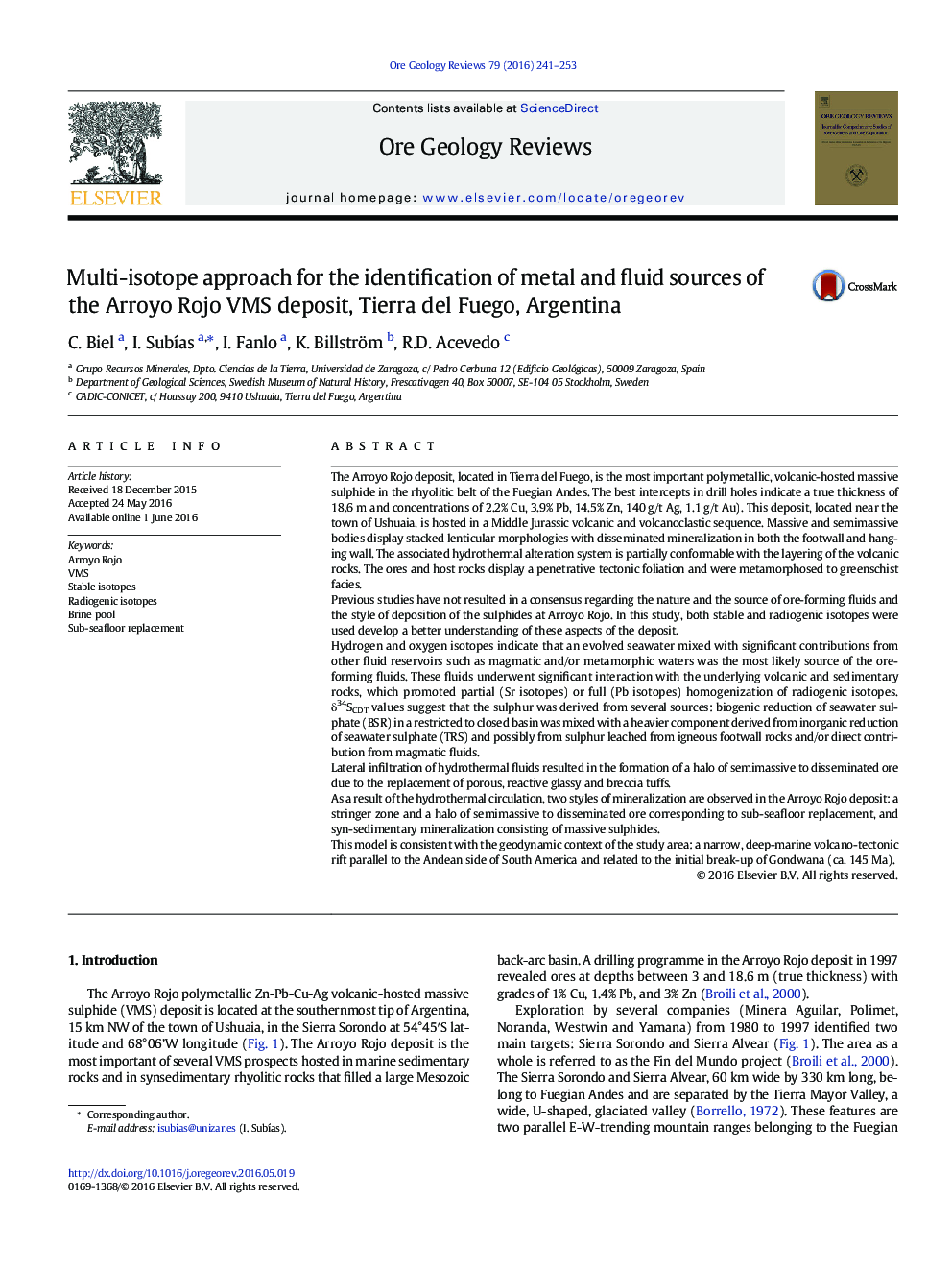| کد مقاله | کد نشریه | سال انتشار | مقاله انگلیسی | نسخه تمام متن |
|---|---|---|---|---|
| 4696795 | 1637227 | 2016 | 13 صفحه PDF | دانلود رایگان |

• The Arroyo Rojo deposit is a polymetallic, volcanic-hosted massive sulphide.
• δ34S values of the Arroyo Rojo deposit suggest multiple sources of sulphur: BSR and TSR combined with deep-seated sulphur.
• Lead and strontium isotopes indicate that these metals were leached from the underlying volcanic and sedimentary rocks.
• Re-equilibration and homogenization of hydrothermal fluids occurred.
• The Arroyo Rojo deposit may be regarded as an intermediate type between brine pool and subseafloor replacement deposits.
The Arroyo Rojo deposit, located in Tierra del Fuego, is the most important polymetallic, volcanic-hosted massive sulphide in the rhyolitic belt of the Fuegian Andes. The best intercepts in drill holes indicate a true thickness of 18.6 m and concentrations of 2.2% Cu, 3.9% Pb, 14.5% Zn, 140 g/t Ag, 1.1 g/t Au). This deposit, located near the town of Ushuaia, is hosted in a Middle Jurassic volcanic and volcanoclastic sequence. Massive and semimassive bodies display stacked lenticular morphologies with disseminated mineralization in both the footwall and hanging wall. The associated hydrothermal alteration system is partially conformable with the layering of the volcanic rocks. The ores and host rocks display a penetrative tectonic foliation and were metamorphosed to greenschist facies.Previous studies have not resulted in a consensus regarding the nature and the source of ore-forming fluids and the style of deposition of the sulphides at Arroyo Rojo. In this study, both stable and radiogenic isotopes were used develop a better understanding of these aspects of the deposit.Hydrogen and oxygen isotopes indicate that an evolved seawater mixed with significant contributions from other fluid reservoirs such as magmatic and/or metamorphic waters was the most likely source of the ore-forming fluids. These fluids underwent significant interaction with the underlying volcanic and sedimentary rocks, which promoted partial (Sr isotopes) or full (Pb isotopes) homogenization of radiogenic isotopes. δ34SCDT values suggest that the sulphur was derived from several sources: biogenic reduction of seawater sulphate (BSR) in a restricted to closed basin was mixed with a heavier component derived from inorganic reduction of seawater sulphate (TRS) and possibly from sulphur leached from igneous footwall rocks and/or direct contribution from magmatic fluids.Lateral infiltration of hydrothermal fluids resulted in the formation of a halo of semimassive to disseminated ore due to the replacement of porous, reactive glassy and breccia tuffs.As a result of the hydrothermal circulation, two styles of mineralization are observed in the Arroyo Rojo deposit: a stringer zone and a halo of semimassive to disseminated ore corresponding to sub-seafloor replacement, and syn-sedimentary mineralization consisting of massive sulphides.This model is consistent with the geodynamic context of the study area: a narrow, deep-marine volcano-tectonic rift parallel to the Andean side of South America and related to the initial break-up of Gondwana (ca. 145 Ma).
Figure optionsDownload as PowerPoint slide
Journal: Ore Geology Reviews - Volume 79, December 2016, Pages 241–253